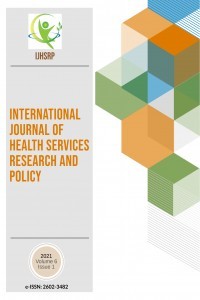HISTOLOGICAL OF CHANGES IN THE AMNIOTIC MEMBRANE AND PLACENTAL VILLOUS BASAL LAMINA IN COMPLICATED PREGNANCIES
HISTOLOGICAL OF CHANGES IN THE AMNIOTIC MEMBRANE AND PLACENTAL VILLOUS BASAL LAMINA IN COMPLICATED PREGNANCIES
Placenta, Basal lamina, Preeclampsia, Gestational diabetes, HELLP syndrome,
___
- [1] Chang MDY, Pollard JW, et al. Mouse placental macrophages have a decreased ability to present antigen. Proceedings of the National Academy of Sciences, 90, 462-466, 1993.
- [2] Bulmer JN, Johnson PM. Macrophage populations in the human placenta and amniochorion. Clinical Experimental Immunology, 57, 393-403, 1984.
- [3] Mues B, Langer D, et al. Phenotypic Characterization of Macrophages in Human Term Placenta. Immunology, 67, 303-307, 1989.
- [4] Sonnenberg A, Linders CJ, et al. The alpha 6 beta 1 (VLA-6) and alpha 6 beta 4 protein complexes: tissue distribution and biochemical properties. J Cell Sci, 96, 207–217, 1990.
- [5] Moore KL. The developing human. 3rd ed; Philadelphia; WB Saunders,6, 111-118, 1983.
- [6] Laga EM, Dirscoll SG,et al . Quantitative studies of human placenta. Biol Neonate, 23, 260-83, 1993.
- [7] Teasudale F. Gestational changes in the function structure of human placenta in relation to fetal growth. Am J Obstet Gynec,137, 560-568, 1980.
- [8] Winick M, Coscia A, et al. Cellular growth in normal placenta. Pediatr, 39:248-51,1987.
- [9] Kumar V, Cotran S, et al. Basic pathology, 6th ed; Pennsylvania; WB Saunders, 3, 1082-1084, 2000.
- [10] Feczko JD, Kluber KM. Cytoarchitecture of muscle in genetic model of murine diabetes. Am J Anat ,182, 224-240, 1988.
- [11] Salvatore AC. The placenta in acute toxemia. Am J Obstet. Gynecol,102, 347-353, 1968.
- [12] Honda M, Toyoda C, et al. Quantitative investigations of placental terminal villi in maternal diabetes mellitus by scanning and transmission electron microscopy. Tohoku J Exp Med, 167, 247–257, 1992.
- [13] Benirschke K, Kaufmann P, Baergen RN. Pathology of the human placenta. 6th ed. Berlin-Germany, 150-155, 2006.
- [14] Gewolb I, Merdian W, et al. Fine structural abnormalities of the placenta in diabetic rats. Diabetes,35, 254–261,1986.
- [15] Pietryga M, Biczysko W, et al. Ultrastructural examination of the placenta in pregnancy complicated by diabetes mellitus. Ginekol Pol, 75,111–8, 2004.
- Yayın Aralığı: Yılda 3 Sayı
- Başlangıç: 2016
- Yayıncı: Rojan GÜMÜŞ
Necmettin ÇİFTÇİ, Sonay BİLGİN
Bahar KARTAL, Mehmet Tahir HATİPOĞLU, Ümit Ali KAYIŞLI, Sevtap HAMDEMİR KILIÇ, Evrim ÜNSAL, Candan ÖZOĞUL
JOB SATISFACTION AS AN OBJECTIVE INDICATOR OF WORK MOTIVATION AMONG INTENSIVE CARE UNIT (ICU) NURSES
Dejan ŽİVANOVİĆ, Jovan JAVORAC, Branislava BRESTOVAČKI SVITLICA, Svetlana STOJKOV
Yusuf NERGİZ, Engin DEVECİ, Muhammet Erdal SAK, Mehmet Sıddık EVSEN, Cenap EKİNCİ, Sebnem NERGİZ, Beyza KARADEDE UNAL, Ugur SEKER
THE STUDY OF THE LONG-LIVERS DYNAMICS IN THE POPULATIONS OF ADJARA IN 2012-2017
Marina KORİDZE, Rusudan KHUKHUNAISHVILI, Temur KARTSIVADZE, Sophiko TSKVITINIDZE, İrina NAKASHIDZE, Kristine MAKHARADZE
FRAILTY AMONG THE BENEFICIARIES OF BATUMI ST. CATHERINE NURSING HOME
Rusudan KHUKHUNAİSHVİLİ, Marina Koridze KORIDZE, Kristine Makharadze MAKHARADZE, Sophiko Tskvitinidze TSKVITINIDZE, Marina Nagervadze NAGERVADZE, İrina Nakashidze NAKASHIDZE, İrakli PARULAVA
CARRIERS OF CHROMOSOME TRANSLOCATIONS FROM THREE MEN WITH AZOOSPERMIA
